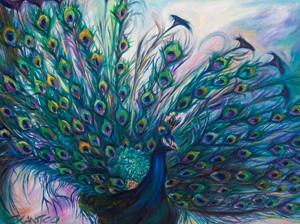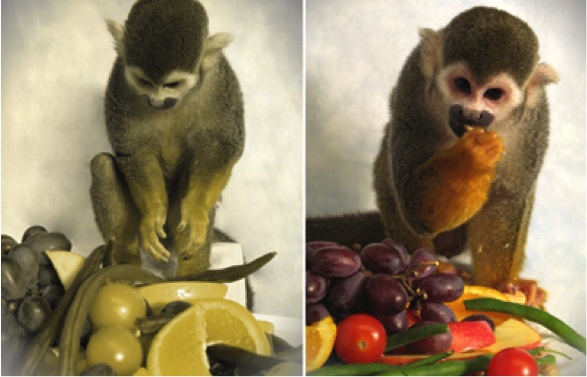It looks like you're using an Ad Blocker.
Please white-list or disable AboveTopSecret.com in your ad-blocking tool.
Thank you.
Some features of ATS will be disabled while you continue to use an ad-blocker.
share:
As Concetta Antico took her pupils to the park for an art lesson, she would often question them about the many shades she saw flashing before her eyes. “I’d say, ‘Look at the light on the water – can you see the pink shimmering across that rock? Can you see the red on the edge of that leaf there?’” The students would all nod in agreement. It was only years later that she realised they were just too polite to tell the truth: the colours she saw so vividly were invisible to them.
What Concetta Antico see's versus what her students see. Antico's painting on the left and the original scene and inspiration for her painting. Can you imagine seeing the world with so many colors? Unbelievable!

The Women with Superhuman Vision
A Tetrachromat women see shades that other's perceive as monotone:

The average human is able to perceive about one million different colors. Researchers suspect that a very small percentage of women are tetrachromat's and are able see 100 times more colors because of extra receptors in their eyes to absorb color. The average human has three cones, tetrachromat's have four.
What is Human Tetrachromacy?
Concetta Antico
Human beings normally have three types of cone cells and are therefore referred to as trichromats. However, it has been suggested that as women have two different X chromosomes in their cells, some of them could be carrying some variant cone cell pigments, thereby possibly being born as tetrachromats and having four different functioning kinds of cone cells.
One study has suggested that 2–3% of the world’s women might have the kind of fourth cone that lies between the standard red and green cones, giving, theoretically, a significant increase in color differentiation.
Yet another study suggests that as many as 50% of women and 8% of men may have four photopigments. The research continues.
Artist Concetta Antico is sharing her gift of Tetrachromacy with us through her art work.

When Concetta Antico looks at a leaf, she sees much more than just green. “Around the edge I’ll see orange or red or purple in the shadow; you might see dark green but I’ll see violet, turquoise, blue,” she said. “It’s like a mosaic of cole
Her artwork is unbelievable, the depth of color is unreal.


It's also interesting to note that, and also ironic, Antico's daughter is color blind. So she's using her skills as an artist and Tetrachromacy to teach painting, including to those that are color blind.
Five years ago, when Antico’s daughter was 7 years old, the family learned that she was colorblind. “I didn’t think it had anything to do with me, but she’s colorblind because of me. I have a mutation,” Antico said.
Another interesting aspect of Human Tetrachromacy, is that all those that have it aren't able to perceive as many colors since they haven't "trained their brains to pay attention" as an artist would.
“I was different than a regular 5-year-old — I was painting at age 7, I was so fascinated with color,” she said. For years, she was exposed to exceptional color, so her brain became wired to take advantage of her tetrachromacy.
This Woman Sees 100 Times More Colors Than The Average Person
Human Tetrachromat's are able to perceive slight variations of the three primary colors. Instead of seeing three primary colors as most of us, they can perceive four! So wild!
This brings us to the first of three major things you need in order to be considered a true, strong tetrachromat.
You need 4 cone classes with substantially different color preferences.
Your brain should be able to distinguish between the activity of all 4 types of cone cells.
This ability to distinguish 4 primary colors should be reflected in your behavior.
Here's an image that shows what a Dichromat would see on the left versus the colors a Trichromat would see. (Not one of Concetta Antico's paintings*)

Dalton the male squirrel monkey was treated with S-opsin. The picture on the left was altered to simulate what Dalton would probably have seen before the treatment, while the picture on the right is what he would have seen as a newly minted trichromat. Source: Neitz lab.
Ask a Neuroscientist: Human Tetrachromacy
a reply to: Jennyfrenzy
S N F Jenny lovely post made my day my week my month..... Wonderful to hear how some people have a talent that is so colourful..... to be able to paint what you see and of course seeing what others cannot!
Me lol I still draw in stick figures and have the normal range of colour....
Thanks for your posting
S N F Jenny lovely post made my day my week my month..... Wonderful to hear how some people have a talent that is so colourful..... to be able to paint what you see and of course seeing what others cannot!
Me lol I still draw in stick figures and have the normal range of colour....
Thanks for your posting
a reply to: IceHappy
Art always makes me feel better!
Tetrachromacy is actually a pretty awesome superpower. We are surrounded by so much beauty on a daily basis, from birds in flight to blooming flowers. The ability to pick up subtle nuances in color just adds to the glory of Mother Nature.
I'm thankful she the ability of artistic expression and is able to share her gift with the rest of us.
Art always makes me feel better!
Tetrachromacy is actually a pretty awesome superpower. We are surrounded by so much beauty on a daily basis, from birds in flight to blooming flowers. The ability to pick up subtle nuances in color just adds to the glory of Mother Nature.
I'm thankful she the ability of artistic expression and is able to share her gift with the rest of us.
edit on 14-10-2014 by Jennyfrenzy
because: eta
a reply to: Jennyfrenzy
It looks like heaven on earth! I'm sure she never gets depressed considering she's constantly surrounded by beautiful colors.
It looks like heaven on earth! I'm sure she never gets depressed considering she's constantly surrounded by beautiful colors.
edit on
14-10-2014 by WeRpeons because: (no reason given)
a reply to: WeRpeons
It would be hard to be depressed seeing that much beauty everyday!
How lucky are we that she is able to share it with us through her paintings. There is always so many negative things taking place in the world on the daily and seeing stories like this are a good reminder to me to take a moment to look around and realize being on Earth really isn't all that bad.
It would be hard to be depressed seeing that much beauty everyday!
How lucky are we that she is able to share it with us through her paintings. There is always so many negative things taking place in the world on the daily and seeing stories like this are a good reminder to me to take a moment to look around and realize being on Earth really isn't all that bad.
This is wonderful you shared this with us. And we are so lucky this woman has these art skills, to share her vision capacity with us like this. Her
artwork is incredible. I particularly like the scenic, nature work she is doing, to allow everyone to see it somehow close to her gift of
sight….
Thanks again for sharing this.
tetra50
Thanks again for sharing this.
tetra50
Great post! Thanks so much!
I'd never heard of this before.
I remember in an art course in high school (1970) we were lucky to have a fairly well know western artist who taught classes for something to fill his time. He gave us all a test to determine how many colors we could see.
We were given a print of a hillside of green plants and parts were circled. We were asked to list how many shades of green we could see inside each circle. Maybe ten percent of us could see many shades, while most of the class could only make out a couple. I wonder if this played a part in that? Before that I had no idea everyone did not see the same colors.
Interesting stuff
I'd never heard of this before.
I remember in an art course in high school (1970) we were lucky to have a fairly well know western artist who taught classes for something to fill his time. He gave us all a test to determine how many colors we could see.
We were given a print of a hillside of green plants and parts were circled. We were asked to list how many shades of green we could see inside each circle. Maybe ten percent of us could see many shades, while most of the class could only make out a couple. I wonder if this played a part in that? Before that I had no idea everyone did not see the same colors.
Interesting stuff
a reply to: Blaine91555
I'd never heard of before either, it's very interesting.
My husband had a similar exercise during Art School, his instructor was able to distinguish hundreds more shades of color and I'm wondering if she is a tetrachromat.
I thought the same, that everyone sees the same color spectrum except for the color blind. Apparently not, lol.
I'd never heard of before either, it's very interesting.
We were given a print of a hillside of green plants and parts were circled. We were asked to list how many shades of green we could see inside each circle. Maybe ten percent of us could see many shades, while most of the class could only make out a couple. I wonder if this played a part in that? Before that I had no idea everyone did not see the same colors.
My husband had a similar exercise during Art School, his instructor was able to distinguish hundreds more shades of color and I'm wondering if she is a tetrachromat.
I thought the same, that everyone sees the same color spectrum except for the color blind. Apparently not, lol.
I wonder.. is there an equivalent concept for sound?
I find it interesting that I can't see much difference (if any) in the comparison pictures and the paintings use of color looks 'normal' to me. Tried to find more, but ran into more of the same, and the BBC article refused to let me scroll down.
In the monkey pic, where are the differences located? I know the scene changed, but the colors look the same. I am pretty certain I do not have tetrachromacy.
I find it interesting that I can't see much difference (if any) in the comparison pictures and the paintings use of color looks 'normal' to me. Tried to find more, but ran into more of the same, and the BBC article refused to let me scroll down.
In the monkey pic, where are the differences located? I know the scene changed, but the colors look the same. I am pretty certain I do not have tetrachromacy.
a reply to: Serdgiam
Interesting idea about sound, if there's supervision then superhearing certainly is possible
The monkey shows the differences between what a dichromatic and trichromatic sees. I used it as an example to show the difference in colors perceived with 2 cones versus 3 cones. Sort of like the first image in the thread of the tree the artist with Tetrachromacy sees versus the tree we see.

Interesting idea about sound, if there's supervision then superhearing certainly is possible
The monkey shows the differences between what a dichromatic and trichromatic sees. I used it as an example to show the difference in colors perceived with 2 cones versus 3 cones. Sort of like the first image in the thread of the tree the artist with Tetrachromacy sees versus the tree we see.

edit on 14-10-2014 by Jennyfrenzy because: eta image
a reply to: Jennyfrenzy
Yes, I am aware of what the purpose of the pics are.
They just look normal to me, but I am male. I googled some more stuff about it and ran into the same.
I will say that many, many refractions/reflections of light have an opalescent quality to them on everything from grass to the sky. I initially suspected it was moisture, but have since ruled that out. However, I have also been diagnosed as being partially colorblind (red/green), but I also seem more sensitive to shades of color than some. So, I struggle to identify the color on its own, but if I have shades to compare I can reliably use that for identification purposes.
I think there is a whole lot more to our sensory organs than we are aware!
Yes, I am aware of what the purpose of the pics are.
They just look normal to me, but I am male. I googled some more stuff about it and ran into the same.
I will say that many, many refractions/reflections of light have an opalescent quality to them on everything from grass to the sky. I initially suspected it was moisture, but have since ruled that out. However, I have also been diagnosed as being partially colorblind (red/green), but I also seem more sensitive to shades of color than some. So, I struggle to identify the color on its own, but if I have shades to compare I can reliably use that for identification purposes.
I think there is a whole lot more to our sensory organs than we are aware!
a reply to: Jennyfrenzy
I was one of those who could see way more colors than others. If that is what that meant, at least this man has that.
I know I'm very visual and of all the things I could loose, loosing my eyesight would kill me.
Sound is where my problems are. I've heard it said if one sense works better, another does the opposite to balance things. I enjoy music, but I don't hear all the nuances that others do.
I'm always playing with my monitor colors and keep a high end one in front of me and use a device to calibrate it. Anything off on colors bothers the heck out of me. Perhaps that's related? Often when I complain about something wrong I'm seeing in the monitor colors, others don't seem to be able to see the problem I see.
I tinker now with 3D modeling and computer graphics, but I love working with materials, shaders and lighting in scenes the most. I can spend hours just tweaking to get the color pallet I want. Sadly monitors don't even begin to show all the colors yet. They are getting better.
My wife can hear things others can't make out. I wonder if we all have one of our senses more capable than others. It would make sense to me that we would evolve our senses a bit differently depending on environment.
Thanks again, very interesting learning something new about this.
I was one of those who could see way more colors than others. If that is what that meant, at least this man has that.
I know I'm very visual and of all the things I could loose, loosing my eyesight would kill me.
Sound is where my problems are. I've heard it said if one sense works better, another does the opposite to balance things. I enjoy music, but I don't hear all the nuances that others do.
I'm always playing with my monitor colors and keep a high end one in front of me and use a device to calibrate it. Anything off on colors bothers the heck out of me. Perhaps that's related? Often when I complain about something wrong I'm seeing in the monitor colors, others don't seem to be able to see the problem I see.
I tinker now with 3D modeling and computer graphics, but I love working with materials, shaders and lighting in scenes the most. I can spend hours just tweaking to get the color pallet I want. Sadly monitors don't even begin to show all the colors yet. They are getting better.
My wife can hear things others can't make out. I wonder if we all have one of our senses more capable than others. It would make sense to me that we would evolve our senses a bit differently depending on environment.
Thanks again, very interesting learning something new about this.
I took a test on seeing colors and could see more colors than most people. I do not see like this woman sees though. I can see hues around flowers
sometimes from pollen but nothing like the pictures.
Some days my vision is better than others for doing this sort of stuff. Some days colors are brighter, when that happens I eat some cabbage and it goes away. I'm not interested in living in that world, I prefer to see things that aren't distracting. My vision changed with the TLE, the filters get bypassed.
Some days my vision is better than others for doing this sort of stuff. Some days colors are brighter, when that happens I eat some cabbage and it goes away. I'm not interested in living in that world, I prefer to see things that aren't distracting. My vision changed with the TLE, the filters get bypassed.
a reply to: rickymouse
Excellent point, never thought of it as being distracting. The grass is always greener on the other side!
I'd still love to have tetrachromatic vision, distractions and all, lol.
I prefer to see things that aren't distracting.
Excellent point, never thought of it as being distracting. The grass is always greener on the other side!
I'd still love to have tetrachromatic vision, distractions and all, lol.
Thank you for posting this! Very interesting... what a "groovy mutation," to borrow a line from X-Men.
This is really cool and thanks for posting.
I had posted something of similar value recently.
Link here.... www.abovetopsecret.com...
I hope the "King of Derailment" aka PHAGE....doesn't find this thread like he did mine.
I had posted something of similar value recently.
Link here.... www.abovetopsecret.com...
I hope the "King of Derailment" aka PHAGE....doesn't find this thread like he did mine.
new topics
-
The Popular Vote does not matter
US Political Madness: 5 minutes ago -
Gaetz withdraws from attorney general consideration
US Political Madness: 3 hours ago -
Bridgewater Triangle
General Chit Chat: 3 hours ago -
Is Russia Using a New Type of Beam Weapon Against Ukraine?
Weaponry: 4 hours ago -
Here is why Western leaders in NATO have zero fear of nuclear warfare. At all. Zero.
World War Three: 5 hours ago -
International Criminal Court Issues Arrest Warrant For Netanyahu
Breaking Alternative News: 6 hours ago -
racist rant, but she made the arguement to get rid of DEI
US Political Madness: 8 hours ago -
Well we know Putins ICBMs won't fail in their silos
World War Three: 8 hours ago
top topics
-
Well we know Putins ICBMs won't fail in their silos
World War Three: 8 hours ago, 12 flags -
racist rant, but she made the arguement to get rid of DEI
US Political Madness: 8 hours ago, 9 flags -
International Criminal Court Issues Arrest Warrant For Netanyahu
Breaking Alternative News: 6 hours ago, 8 flags -
Is Russia Using a New Type of Beam Weapon Against Ukraine?
Weaponry: 4 hours ago, 8 flags -
Gaetz withdraws from attorney general consideration
US Political Madness: 3 hours ago, 5 flags -
Here is why Western leaders in NATO have zero fear of nuclear warfare. At all. Zero.
World War Three: 5 hours ago, 4 flags -
Why isn't Psychiatry involved?
Social Issues and Civil Unrest: 14 hours ago, 4 flags -
Bridgewater Triangle
General Chit Chat: 3 hours ago, 4 flags -
Help in song interpretation
Music: 16 hours ago, 3 flags -
The Popular Vote does not matter
US Political Madness: 5 minutes ago, 0 flags
active topics
-
Russia Ukraine Update Thread - part 3
World War Three • 6859 • : Oldcarpy2 -
The Popular Vote does not matter
US Political Madness • 0 • : TheSemiskepticII -
Well we know Putins ICBMs won't fail in their silos
World War Three • 100 • : Oldcarpy2 -
International Criminal Court Issues Arrest Warrant For Netanyahu
Breaking Alternative News • 33 • : JJproductions -
Gaetz withdraws from attorney general consideration
US Political Madness • 10 • : Kaiju666 -
Gaetz ethics investigation results "hacked".
US Political Madness • 35 • : marg6043 -
Mood Music Part VI
Music • 3711 • : SLAYER69 -
Is Russia Using a New Type of Beam Weapon Against Ukraine?
Weaponry • 12 • : CarlLaFong -
-@TH3WH17ERABB17- -Q- ---TIME TO SHOW THE WORLD--- -Part- --44--
Dissecting Disinformation • 3340 • : Thoughtful3 -
How can you defend yourself when the police will not tell you what you did?
Posse Comitatus • 102 • : Oldcarpy2
